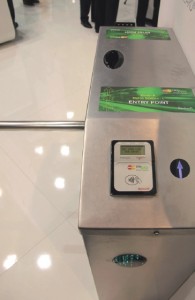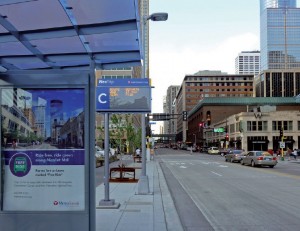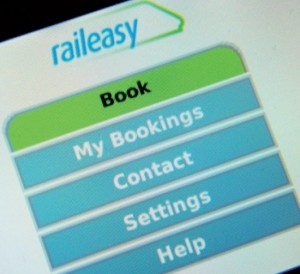An overview of different Near field communication (NFC) applications that can be used in the public transit industry
by Randy Vanderhoof, Smart Card Alliance
 Near field communication, allowing data to be exchanged between electronic devices in close proximity, is an innovation that will significantly influence the direction and growth of mobile commerce. NFC is expected to be used for a wide variety of applications, including payments, coupons, merchant promotions, and transit ticketing. As a short range or proximity technology, NFC differs significantly from more common forms of mobile communication. Mobile payment implementations, in particular, typically require a backend server and transmit by Randy Vanderhoof, Smart Card Alliance data using mobile channels, such as short message service (SMS), mobile applications (apps), or a browser.
Near field communication, allowing data to be exchanged between electronic devices in close proximity, is an innovation that will significantly influence the direction and growth of mobile commerce. NFC is expected to be used for a wide variety of applications, including payments, coupons, merchant promotions, and transit ticketing. As a short range or proximity technology, NFC differs significantly from more common forms of mobile communication. Mobile payment implementations, in particular, typically require a backend server and transmit by Randy Vanderhoof, Smart Card Alliance data using mobile channels, such as short message service (SMS), mobile applications (apps), or a browser.
Mobile payment alternatives currently include the use of contactless stickers, microSD cards, and 2-D bar codes. In contrast, mobile payment with NFC technology relies on a handset provisioned with a payment application, which may be provided by one of the major card brands and personalized with a payment account from the consumer’s financial institution.
Mobile NFC payment and settlement processes are identical to the processes executed when a contactless or magnetic-stripe credit or debit card is used for payment. The difference is that NFC-enabled devices offer two-way functionality; that is, an NFC-enabled device may act as both a contactless card and a contactless reader. This supports interactive processes whereby the consumer may collect information on the NFC-enabled device in the form of coupons, directions, web site/app store links, or buyer incentives from electronic boards, posters, or maps. Based on this information, the consumer can then choose to make a purchase. The actual payment transaction may be the final step in a series of data exchanges between the NFCenabled device and a contactless point-ofsale (POS) reader. In short, an NFC-enabled device offers additional options for obtaining information to make purchase decisions, as well as a convenient way to make contactless purchases.
Transit mobile applications
 The public transit mobile landscape includes passenger information needs, frontline employee communication, vehicle fleet monitoring, and facilities management. Each of these areas offers both challenges and opportunities for improving safety, customer satisfaction, and service reliability. Most transit agencies have deployed wireless or mobile applications by supplementing conventional radio systems with a range of new applications, such as automated stop announcements, automatic vehicle location, and automated passenger counters. NFC technology builds upon these capabilities to provide personalized services for mobile computing, geospatial information, and even social media.
The public transit mobile landscape includes passenger information needs, frontline employee communication, vehicle fleet monitoring, and facilities management. Each of these areas offers both challenges and opportunities for improving safety, customer satisfaction, and service reliability. Most transit agencies have deployed wireless or mobile applications by supplementing conventional radio systems with a range of new applications, such as automated stop announcements, automatic vehicle location, and automated passenger counters. NFC technology builds upon these capabilities to provide personalized services for mobile computing, geospatial information, and even social media.
An NFC-enabled phone provides passengers with access to the current array of information and services now accessible using broadband cellular and Wi-Fi. In addition, using NFC, passengers can instantly download a bus timetable, check fares, or determine a vehicle location by touching a phone to a kiosk or ‘smart’ poster
Ticketing and payment
Several successful trials have revealed that passengers also want to be able to pay transit fares with a mobile device. Ticketing and payment are applications that are well suited to NFC technology. By touching a phone on a bus fare box or NFC turnstile, the passenger could either process a virtual card resident in their phone or initiate an authentication process with a backoffice server that can be configured to charge a flat fare or a distancebased (i.e., tag in-tag out) fare. As an early adopter of contactless technology for fare payment, the transit industry is well positioned to take advantage of NFC technology for both payment and nonpayment applications. Riders in several major cities are already accustomed to waving or tapping contactless cards against fare boxes and turnstile readers. Enabling mobile phones with NFC lets riders pay fares directly at the point of entry to the transit system. In a typical sequence, a transit rider could plan a trip and prepay the fare by connecting to a transit agency’s Web site; the electronic ticket or fare can be downloaded to the mobile phone and presented to a reader at a transit station or bus fare box. Payment for parking is another option if the parking lot entry point is equipped with an NFC reader. Transit customers can then touch an NFC-enabled phone to the reader to complete the payment transaction.
Standards and Specifications
 NFC-enabled devices are governed by multiple standards (ISO/IEC standard 18092, ETSI standard TS 102 10 V1.1.1 [2003-03], and ECMA standard 340) and by specifications published by the industry association, the NFC Forum. ISO/IEC 18092 allows for backward compatibility with current contactless devices by supporting ISO/IEC 14443 (the standard used by paymentnetwork- branded contactless payment cards and devices) and the Japanese Industrial Standard (JIS) X 6319-4 (also known as FeliCa) contactless interface protocols. An NFCenabled device can operate in reader/writer, peer-to-peer, and card emulation mode. For mobile contactless payments and mobile ticketing, the NFCenabled mobile device operates in card emulation mode; an external reader sees it as a traditional contactless smart card. Payment information is stored in the mobile phone in a secure element (SE), which is a smart card chip that protects stored data and enables secure transactions.
NFC-enabled devices are governed by multiple standards (ISO/IEC standard 18092, ETSI standard TS 102 10 V1.1.1 [2003-03], and ECMA standard 340) and by specifications published by the industry association, the NFC Forum. ISO/IEC 18092 allows for backward compatibility with current contactless devices by supporting ISO/IEC 14443 (the standard used by paymentnetwork- branded contactless payment cards and devices) and the Japanese Industrial Standard (JIS) X 6319-4 (also known as FeliCa) contactless interface protocols. An NFCenabled device can operate in reader/writer, peer-to-peer, and card emulation mode. For mobile contactless payments and mobile ticketing, the NFCenabled mobile device operates in card emulation mode; an external reader sees it as a traditional contactless smart card. Payment information is stored in the mobile phone in a secure element (SE), which is a smart card chip that protects stored data and enables secure transactions.
For transit, card emulation mode can facilitate either a conventional read/write transit transaction or an accountbased open payments transaction. NFC-enabled mobile phones are compatible with the contactless smart card acceptance infrastructure (based on ISO/IEC 14443). NFC phones can therefore be used with current contactless payment and ticketing services without requiring additional investment in an already contactless-enabled terminal infrastructure. Current contactless applications such as MasterCard PayPass, Visa pay- Wave, or a transit fare payment card can be supported on a mobile phone—a new form factor. Use of a mobile phone for contactless applications replaces the “passive” plastic card with something much more powerful—a mobile device on which applications can be managed online and through which the consumer experience can be greatly enhanced, thanks to the mobile device’s rich user interface. The NFC Forum4 has developed and released implementation specifications and has also launched a certification program that checks devices for compliance with NFC Forum specifications. Compliant devices behave consistently, facilitating an interoperable infrastructure.
Open bank card payment
 One of the significant benefits to transit operators of supporting a fare collection system that accepts contactless bank cards is that other payment technologies compatible with ISO/IEC 14443 can easily be integrated into the system. A transaction processing model that supports contactless bank cards will support those same applications to the same extent, using NFCbased card emulation. While basic integration for a payment transaction is relatively simple, NFC-enabled devices can support richer interactive user experiences than can a card, providing the consumer with both greater control and greater flexibility. NFC-enabled applications can deliver more robust capabilities in the three primary stages of the consumer fare payment life cycle:
One of the significant benefits to transit operators of supporting a fare collection system that accepts contactless bank cards is that other payment technologies compatible with ISO/IEC 14443 can easily be integrated into the system. A transaction processing model that supports contactless bank cards will support those same applications to the same extent, using NFCbased card emulation. While basic integration for a payment transaction is relatively simple, NFC-enabled devices can support richer interactive user experiences than can a card, providing the consumer with both greater control and greater flexibility. NFC-enabled applications can deliver more robust capabilities in the three primary stages of the consumer fare payment life cycle:
- Fare product acquisition
- System entry and exit, and transaction processing
- Post-purchase inspection and processing (consumer and operator)
An NFC-enabled mobile device equipped with an open payment application can make fare product acquisition more convenient for consumers. Consumers can purchase products using mobile applications and mobile Web sites or tap on NFC tags available throughout the transit system, making fare product purchases possible literally anywhere.
Transaction processing
NFC-enabled devices function in a manner very similar to contactless cards at points of entry (and exit) when a transaction is processed. However, passengers have more control over how the information is presented
A key benefit is the passenger’s ability to access available balances or the status of the payment account or of prepurchased products, such as transit stored-value or multiride products, before reaching the boarding point. Additionally, different accounts can be selected for different journeys, avoiding possible conflicts when a passenger has multiple contactless accounts.
Another key benefit of the NFC-enabled mobile wallet is that passengers can turn the device’s payment capability on or off as they choose. For example, a passcode may be required and an account selected before the device is presented to the gate, enhancing security and mitigating potential fraud.
Alternatively, passengers can use the wallet to set up an easy-to-use ‘card’ mode, in which a default application is selected, the NFC antenna operates in passive mode, and no direct passenger interaction is required to complete a payment. If the transit operator can support offline authorization, counters in NFC-enabled mobile devices can be updated over-the-air, without requiring an online transaction, resulting in more frequent counter refresh and a lower likelihood of passengers running out of funds for offline transactions.
Inspection and processing
 After a transaction has occurred, a mobile device or application can present the passenger with a current balance or recent ride history. A transit app stored on the mobile device can retain a record of recent transactions that can be used for revenue inspection.
After a transaction has occurred, a mobile device or application can present the passenger with a current balance or recent ride history. A transit app stored on the mobile device can retain a record of recent transactions that can be used for revenue inspection.
Passengers are likely to have multiple NFC applications on their mobile devices, including multiple transit applications. One such specification to manage multiple MIFARE applications is MIFARE4Mobile. This specification extends the use of MIFARE implementations to a variety of secure element form factors, while still leveraging the full capabilities of the mobile device. In addition, NFC-enabled mobile phones can be used as a ticket vending machine to top-up an existing contactless transit fare payment card.
After the fare product is successfully downloaded to the NFC phone, tapping the phone to a reader validates the ticket and permits access to the transportation system. Alternatively, in ungated systems, the ticket is stored on the handset for inspection and/or electronic validation.
Payment validation
Putting payment and ticketing applications on NFC handsets facilitates payment and payment validation for merchants, banks, and mobile network operators (MNOs), as well as passengers. For merchants, NFC payments offer a fast payment experience using existing contactless payment readers. In addition, passengers have a record of even the smallest payments, which is more difficult when payments are made in cash. Revenue enforcement officers can also use NFC-enabled mobile devices to validate proper fare payment.
Mobile strategy
As transit agencies explore the use of new fare payment and collection systems based on open standards, it is becoming increasingly clear that developing a mobile strategy is critical to those efforts and may carry benefits that extend beyond those directly related to fare collection. Mobile devices can provide additional functionality that strengthens a transit agency’s ability to derive value from both current and new customers while providing convenience and value-added services that enhance the customer experience. For example, integrated mobile applications that combine fare payment with trip planning and service status information allow for a more personal interaction with the transit agency.
